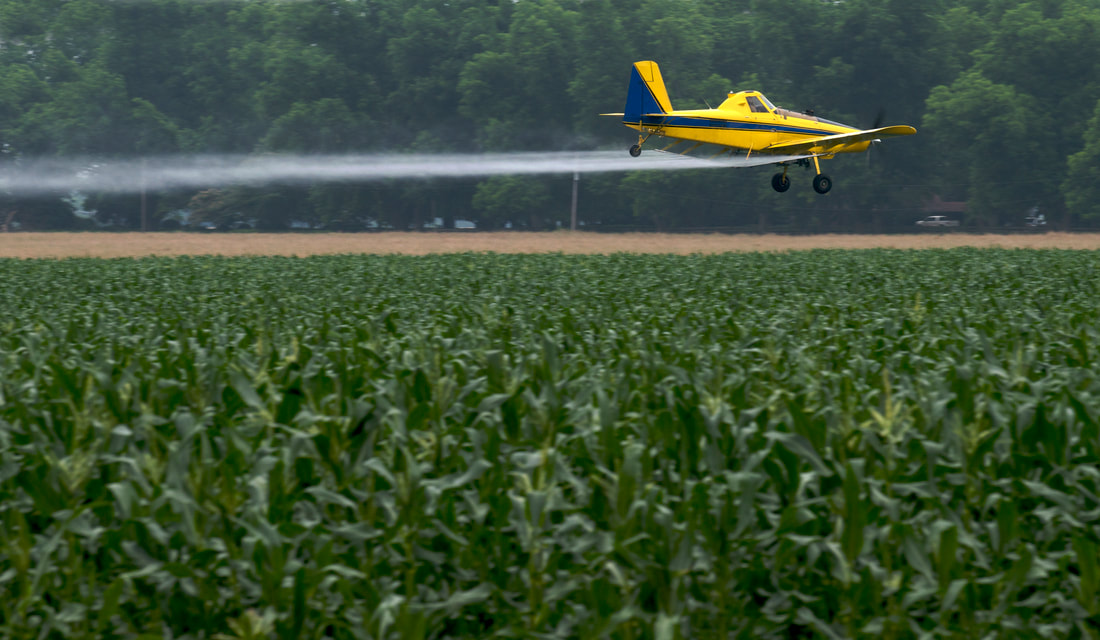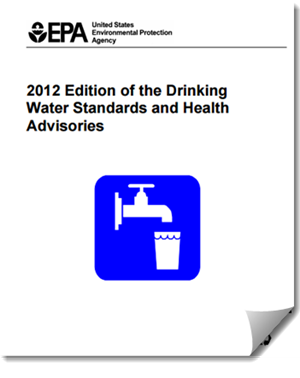Environmental Exposure Standards/Guidelines
The Environmental Protection Agency (EPA) is responsible for US-wide laws that require determination and enforcement of environmental exposure standards. In addition, EPA has the authority to prepare recommended exposure guidelines for selected environmental pollutants. Similar organizations exist in US states, and in other countries and groups of countries (such as the European Commission for European Union member countries).
The EPA is responsible for developing exposure standards for:
Pesticides
The EPA is responsible for developing exposure standards for:
- Pesticides
- Water pollutants
- Air pollutants
- Hazardous wastes
Pesticides
|
Pesticides cannot be marketed until they have been registered by the EPA in accordance with the Federal Insecticide, Fungicide, and Rodenticide Act (FIFRA). In order to obtain registration, a pesticide must undergo an extensive battery of toxicity tests, chemistry analyses, and environmental fate tests.
The Food Quality Protection Act of 1996 (FQPA) changed the way that pesticides were regulated by requiring investigation of:
Certain pesticides have been determined by the EPA to pose minimal risk to health or to the environment and are exempt from FIFRA registration. A primary exposure standard for pesticides is the pesticide tolerance for food use This standard specifies the pesticide residue allowed to remain in or on each treated food product. The EPA residues risk assessment covers:
Water Pollutants |
Figure 1. Dusting crops with pesticides
(Image Source: iStock Photos, ©) Figure 2. Aerosol spray cans of pesticide
(Image Source: iStock Photos, ©) |
Access to safe drinking water and control of water pollution are regulated by the Safe Drinking Water Act (SDWA) and the Clean Water Act (CWA). Under the SDWA, the EPA conducts risk assessments and issues Maximum Contaminant Levels (MCLs) for naturally-occurring and man-made contaminants in drinking water. The MCL is the acceptable exposure level which, if exceeded, requires immediate water treatment to reduce the contaminant level.
In addition to establishing MCLs, the EPA can propose recommended exposure guidance for drinking water contamination. As an interim procedure, maximum contaminant level goals (MCLGs) may be recommended for long-term exposures to contaminants in drinking water. Generally, no allowable exposure can be recommended for a carcinogenic chemical. When the MCL is issued, an acceptable exposure level based on a cancer risk assessment may be proposed for the MCL.
In addition to establishing MCLs, the EPA can propose recommended exposure guidance for drinking water contamination. As an interim procedure, maximum contaminant level goals (MCLGs) may be recommended for long-term exposures to contaminants in drinking water. Generally, no allowable exposure can be recommended for a carcinogenic chemical. When the MCL is issued, an acceptable exposure level based on a cancer risk assessment may be proposed for the MCL.
|
EPA prepares health advisories (HAs) as voluntary exposure guidelines for drinking water contamination. The HAs provide exposure limits for 1-day, 10-day, longer-term, or lifetime exposure periods. They pertain to both cancer and noncancer risks. The formula used to derive a health advisory differs from that for the ADI or RfD in that the HAs pertain to short-term as well as long-term exposures. In addition, human body weight and drinking water consumption are included in the formula.
Data from toxicology studies such as the duration of exposure and the exposure route (such as oral) must be represented in the HAs. For example, the 10-day HA must be based on a NOAEL or LOAEL derivation that was obtained from an animal toxicology study of approximately 10 days duration (routinely 7- to 14-day toxicity studies). A longer-term HA applies to humans drinking contaminated water for up to 7 years (which could represent 10% of a human's 70-year lifespan). Because 90 days is about 10% of a rat's expected lifespan, the 90-day subchronic study with rats is considered appropriate for providing the basis for the longer-term HA assessment. A life-time HA (representing lifetime exposure to a toxicant in drinking water) is also determined for noncarcinogens. The procedure uses the RfD risk assessment with adjustments for body weight of an adult human (70 kg) and drinking water consumption of 2 L/day. |
Figure 3. EPA issues health advisories as voluntary exposure guidelines for drinking water contamination
(Image Source: Adapted from EPA) |
In addition to drinking water standards, the EPA is authorized under the Clean Water Act (CWA) to issue exposure guidance for controlling pollution in ground water. The intent is to provide clean water for fishing and swimming rather than for drinking purposes. It provides a scheme for controlling the introduction of pollutants into navigable surface water. The recommendations for ground water protection are known as ambient water quality criteria.
The ambient water quality criteria are intended to control pollution sources at the point of release into the environment. While these criteria may be less restrictive than the drinking water standards, they usually are the same numeric value. For example, the MCL for drinking water and the ambient water quality criteria for ground water for lead are the same: 0.05 mg/L of water.
The ambient water quality criteria are intended to control pollution sources at the point of release into the environment. While these criteria may be less restrictive than the drinking water standards, they usually are the same numeric value. For example, the MCL for drinking water and the ambient water quality criteria for ground water for lead are the same: 0.05 mg/L of water.
Figure 4. A scientist tests the water for toxicity
(Image Source: iStock Photos, ©)
(Image Source: iStock Photos, ©)
Air Pollutants
Air emission standards are issued by EPA under the Clean Air Act (CAA). The CAA authorizes the issuance of National Ambient Air Quality Standards (NAAQS) for air pollution. There are two types of NAAQS:
When air emissions exceed the NAAQS levels, the polluting industry must take action to reduce emissions to acceptable levels.
Air emission standards are issued by EPA under the Clean Air Act (CAA). The CAA authorizes the issuance of National Ambient Air Quality Standards (NAAQS) for air pollution. There are two types of NAAQS:
- Primary NAAQS standards set limits to protect public health, including people at increased risk (preexisting heart or lung disease, children, older adults).
- Secondary NAAQS standards relate to public welfare, such as crops, animals, and structures.
- Carbon monoxide
- Sulfur oxide
- Oxides of nitrogen
- Ozone
- Hydrocarbons
- Particulates
- Lead
When air emissions exceed the NAAQS levels, the polluting industry must take action to reduce emissions to acceptable levels.
Figure 5. A factory releases pollutants into the air
(Image Source: iStock Photos, ©)
(Image Source: iStock Photos, ©)
Hazardous Wastes
Hazardous wastes are regulated under the Resource Conservation and Recovery Act (RCRA) and the Comprehensive Environmental Response, Compensation and Liability Act (CERCLA), commonly known as Superfund. RCRA regulates hazardous and nonhazardous solid waste, including chemical waste produced by industrial processes, medical waste, and underground storage tanks.
The main purpose of CERCLA is to clean up hazardous waste disposal sites. EPA has established standards known as Reportable Quantities (RQs). Companies must report to EPA any chemical release that exceeds the RQ. RQs evaluate physical, chemical, and toxicological properties of a substance. These are called primary criteria and include aquatic toxicity, acute mammalian toxicity (oral, dermal, and inhalation), ignitability, reactivity, chronic toxicity, and potential carcinogenicity. Secondary criteria evaluate how a substance degrades in the environment.
Minimal Risk Levels (MRLs) for noncancer toxic effects are derived by the Agency for Toxic Substances and Disease Registry (ATSDR), which has a congressional mandate to investigate the health effects of hazardous substances in the environment. MRLs are estimates of daily human exposures that are likely to be without an appreciable risk of adverse effects over a specified duration of exposure. MRLs are derived for acute (14 days or less), intermediate (15–364 days), and chronic (365 days or more) exposures for inhalation or oral routes.
Hazardous wastes are regulated under the Resource Conservation and Recovery Act (RCRA) and the Comprehensive Environmental Response, Compensation and Liability Act (CERCLA), commonly known as Superfund. RCRA regulates hazardous and nonhazardous solid waste, including chemical waste produced by industrial processes, medical waste, and underground storage tanks.
The main purpose of CERCLA is to clean up hazardous waste disposal sites. EPA has established standards known as Reportable Quantities (RQs). Companies must report to EPA any chemical release that exceeds the RQ. RQs evaluate physical, chemical, and toxicological properties of a substance. These are called primary criteria and include aquatic toxicity, acute mammalian toxicity (oral, dermal, and inhalation), ignitability, reactivity, chronic toxicity, and potential carcinogenicity. Secondary criteria evaluate how a substance degrades in the environment.
Minimal Risk Levels (MRLs) for noncancer toxic effects are derived by the Agency for Toxic Substances and Disease Registry (ATSDR), which has a congressional mandate to investigate the health effects of hazardous substances in the environment. MRLs are estimates of daily human exposures that are likely to be without an appreciable risk of adverse effects over a specified duration of exposure. MRLs are derived for acute (14 days or less), intermediate (15–364 days), and chronic (365 days or more) exposures for inhalation or oral routes.
Knowledge Check (Solutions on next page)
1) The exposure standard established by the EPA for the pesticide residue allowed to remain in or on each treated food product is called the:
a) Pesticide tolerance for food use
b) Reportable quantity of pesticides
c) Maximum Contaminant Level (MCL)
2) The EPA establishes exposure standards for natural and man-made contaminants in drinking water. These standards are called:
a) Ambient Water Quality Criteria
b) Maximum Contaminant Level Goals (MCLGs)
c) Maximum Contaminant Levels (MCLs)
3) What is the difference between primary National Ambient Air Quality Standards (NAAQS) and secondary NAAQS?
a) Primary NAAQS relate to public welfare (for example, crops, animals, and structures); secondary NAAQS set limits to protect public health
b) Primary NAAQS set limits to protect public health; secondary NAAQS relate to public welfare
c) Primary NAAQS are legally enforceable; secondary NAAQS are not
4) The Agency for Toxic Substances and Disease Registry (ATSDR) estimates levels for daily human exposure to chemicals that are likely to be without an appreciable risk of adverse effects for specified periods of exposure. These are known as:
a) Minimal Risk Levels (MRLs)
b) Maximum Contaminant Levels (MCLs)
c) Reportable Quantities (RQs)






